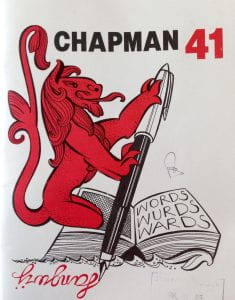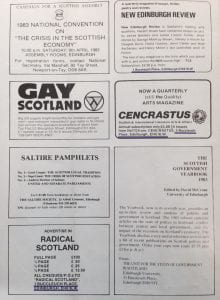How should we read and study the magazine, viewed as text, artefact or cultural form? Patrick Collier offers a stimulating crash-course in theorising magazine culture.
 Congratulations to the organizers for persevering through the pandemic and getting together the first virtual meeting of the network. In advance of our discussion, I offer the following précis, distilled from a draft book chapter entitled “The Magazine In Theory.” Rather than address the many questions begged in that title, I’ll bring the précis down to earth by calling it “Six or Seven (or so) Ways to Read a Magazine.”
Congratulations to the organizers for persevering through the pandemic and getting together the first virtual meeting of the network. In advance of our discussion, I offer the following précis, distilled from a draft book chapter entitled “The Magazine In Theory.” Rather than address the many questions begged in that title, I’ll bring the précis down to earth by calling it “Six or Seven (or so) Ways to Read a Magazine.”
I choose multiplicity to avoid prescription. While there have been efforts, in periodical studies, to establish firm critical protocols for the study of magazines, heterogeneity and multiplicity have been the hallmarks of the culture of magazines since the middle of the nineteenth century, when they became a central cultural form in the West. So, multiplicity and heterogeneity should also, I think, characterize our engagement with magazines as scholars. As you will see, some of these ways of reading will exist in tension or even in conflict with one another, but that too is all to the good in the study of a cultural form that, singly and across the broader field, plays host to a huge range of voices, genres, postures, and disciplines.
Read magazines closely (1).
In surveying theoretical/methodological writing about periodicals dating back to the late 1980s, I am struck that there was a time, no so long ago, when the close reading of magazines needed to be defended. In separate chapters in Investigating Victorian Journalism (1990), Lyn Pykett and Margaret Beetham articulated foundational methodological questions and provisional answers that remain generative today. These include Pykett’s suggestion that periodicals (and their contents) be read both for their formal properties and as participants in broader cultural discourses. Writing at the high-water mark of High Theory, Pykett borrows Barthes’s sense of the “text as methodological field” to foreground, effectively, two styles of close reading: deconstructive and New Historicist close reading—the one to register and analyze the deep structures of signification in periodicals and the second to foreground “discourse and discursive communities.” All this would build up periodical studies (though she does not use the term) as “a new interdisciplinary formation” that “[reinstates] history, economics, and sociology” in humanities scholarship.
Read magazines closely (2)—as magazines.
The invitation to read magazines closely foregrounds the question of how magazines signify distinctly from other cultural forms—in other words, the status of magazines as aesthetic objects in their own right, artifacts that produce distinct meanings not identical with or reducible to the plain text of their contents. As Sean Latham and others have noted, magazines require “a new kind of formalist reading practice” that can make visible “the specific formal constraints and affordances of magazines themselves.” Jerome McGann and the late George Bornstein enabled this sort of reading by articulating the concept of the “bibliographic code”—the meaning-effects of such physical, textual features as layout, typography, paper quality, arrangement, etc.—and applying it to the complexes created when literary works appeared in specific magazine contexts. Most broadly, reading magazines as magazines means treating them as primary texts rather than neutral containers of textual evidence to be “disaggregated,” as Latham and Robert Scholes put it in their 2006 program piece, “The Rise of Periodical Studies.” But I don’t need to lecture on the importance of treating magazines as magazines before a group called the Scottish Magazines Network, so on to greater specifics.
Read magazines as serials.
Perhaps the two defining elements of the magazine as an artifact are the heterogeneity of its content—the word “magazine” enters the language, in its contemporary usage, to signify textual objects that gather together multiple texts by multiple authors—and its serial periodicity. A large majority of magazines appear serially at regular intervals, and most others aspire to this condition without meeting it, folding after a few issues or struggling to maintain a regular publication schedule. But seriality and periodicity are not merely flat facts about magazine form—they are also critical frames through which magazines and their contents can be and are being read, with increasing frequency and sophistication, by critics. Focusing on seriality allows us to raise question about how magazines interact and seek to interact with readers (think of the use of serial fiction or recurring features to capture and hold readers), what cultural work specific magazines and magazine genres do (reiterating cultural values and norms, constructing and reiterating such subject positions as reader, citizen, consumer, housewife, etc.), even how some magazines achieve something like a consistent voice. To read a magazine as a serial means not just to read across issues and years but to foreground the effects of seriality on a magazine’s aesthetic and economic work. To read a magazine as a casual reader is to know that you are entering into a text that predates the instance you hold in your hands and promises to extend forward to future encounters. To read seriality as a scholar is to look for particular effects, patterns, and agendas enabled, hindered, or spontaneously produced by this seriality.
Read the magazine both as and against genre.
To speak of genre in magazines is at once inescapable and insufficient. As an artifact whose rise to prominence fuelled and participated in the growth of the first mass-media and mass-entertainment industry (late nineteenth-century print culture), magazines helped to establish mass media as at once relentlessly genre-driven and profligate in generating new and hybrid genres. (Compare the magazine and newspaper markets of the 1890s with Hollywood film in the classical era or TV in the current streaming age: in all these settings everything falls into a genre, and new genres keep appearing). Historical readers, magazine contributors, editors, and publishers all viewed their products as situated within an available generic framework. But it is crucial to distinguish between genres as historical participants understood them and genres devised retrospectively by critics to organize the field of objects. Think of the terms “little magazine” and “literary magazine”—useful if treated as provisional heuristics, and sometimes evoked by historical figures, but also anything but stable and consistent facts in the world. As Donal Harris recently suggested in constructing “Big Magazines” as his own provisional category, terms such as “little” and “literary” probably more accurately and consistently denote “attitudes towards readership” than they do “size or content.”
Read the magazine as an object in the world.
Beetham noted in 1990 that periodicals have an economic and a signifying function, with most being born out of mixed motives, combining a desire to make money or forge a career with aims that are expressive, aesthetic, or political—the desire to “make one’s meanings stick.” Most people who study periodicals intently are drawn to their significance—the roles they played in fuelling literary careers, or in the cultural contestation over meaning, value, and power. As suggested above, a magazine’s physical properties have meaning effects; but to consider a magazine’s economics and its objecthood thoroughly takes us further. A “magazine” is not a single object but a serial object in this literal, physical sense. A single “magazine” title is actually an expansive set of single physical objects, objects whose production creates and destroys in the physical world—creates jobs and livelihoods and many kinds of economic activity; destroys trees and creates waste and requires the production of ink and the burning of fossil fuel to produce electricity and transport issues to readers and newsstands. The economy of publishing transforms and helps to create the social world, and it constantly forms and transforms the physical world. For instance, as James Mussell has noted, periodicals “both represent and move through space, helping to transform it [space] into circulation routes, spaces of commerce, library space, educational spaces, etc.” Magazines’ impact on the physical world is transforming anew today, as the newest and in some cases the most compelling magazines exist on the (to most of us) invisible and electricity-guzzling infrastructure of internet servers. To read magazines as objects is both to revivify Richard Altick’s “sociology of authorship” by recognizing their crucial and multiple economic effects and to recognize their blunt materiality as objects on/of an exhaustible planet.
Read magazines critically. And uncritically. And….
Having taught undergraduate seminars on modern periodicals, I find that reading magazines with college students is valuable because it foregrounds and even exaggerates problems of interpretation that apply to all reading. When we construct an interpretation of a Wallace Stevens poem taken from a teaching anthology, we (and our students) may quite easily fall into the illusion that the metanarrative we construct has some fundamental and stable relation to the words on the page—some objective or absolute existence independent of us and our acts of reading. When we foreground the magazine as text, this illusion disappears, in part because—as we all know—no two readers consume a magazine in precisely the same way. To borrow a phrase from Scholes, the “protocols of reading” that emerge in the contact between magazines and their consumers are much looser and more individualized than those enacted in the reading of a novel or a poem. It is much harder to sustain the illusion, when we construct a metanarrative out of our reading of a magazine, that we are recreating a reading experience some historical subject(s) might have had or that we are uncovering some objective thing that pre-existed our act of interpretation. Every reading of a historic magazine quite clearly builds something new, even as it may be used as evidence to posit a broader cultural pattern, a “structure of feeling” per Raymond Williams, or something like it.
I write this even as my Twitter feed is aflutter (or a-Twitter?) with discussions of “post-critique”—a rethinking of the kinds of close reading that have dominated the critical enterprise since the theory revolution. I began here by celebrating continued close reading of periodicals, so it is worth noting that I am doing so in a setting in which close reading is under a new and uncommon degree of scrutiny. At least since the 2009 issue of Representations subtitled “How We Read Now,” scholars have problematized the dominance of “symptomatic reading” and its “hermeneutics of suspicion,” in which close-reading’s objective is the revelation of historical power relations encoded within the text, which is generally found to sustain those relations, reiterating dominant values and assumptions. Rita Felski’s new Hooked: Art and Attachment, a follow-up to her 2015 The Limits of Critique, attempts to steer the enterprise of literary scholarship away from critical argument and “explanation” and towards understanding and validating the affective work literary texts enable. In doing so she laments scholars’ attachment to critique and celebrates, instead, the attachment of lay readers to art, which becomes an aspiration for scholarship in the future. More diversely, the 2009 Representations writers presented a range of alternatives to symptomatic reading, from Morettian distant-reading (which would require another blog post, or twenty) to “surface reading,” “just reading,” “reading for patterns” and more.
These are all valuable perspectives. Indeed, what a scholar does when confronted with the plenitude among and within magazines will necessarily involve a range of reading modes, including those referenced here, not to mention skimming, skipping, and pausing to describe such magazine elements as page design, recurring format, typography, size, and more. Indeed, the heat around the current critique/post-critique debate threatens to create a binary that belies the complexity and both/and-ness of much of the actual reading that scholars do. And here again the particulars of periodical scholarship are illustrative. So-called symptomatic reading does have an important place in periodical studies: given the serial (and thus iterative) nature of magazines and their importance, even cultural dominance, in various historical contexts, scholarly readings that are critical in the agonistic sense are important. As someone whose primary specialty is British modernism, I am more interested in suspicious readings that probe rhetorics of violence and traces of misogyny in Blast than I am in readings that celebrate its quite well-documented role in the early emergency of modernisms in Britain. But my time as editor of the Journal of Modern Periodical Studies, and my own scholarly impulses and ad-hoc practices, underscore that 1) sympathetic and even celebratory readings of periodicals are as common as 2) symptomatic and/or suspicious ones, and equally common are 3) readings whose main agenda is simply to claim historic importance for an un- or understudied object.
I take it that the remit of the Scottish Magazines Network, as a collaboration aimed at establishing infrastructure and relationships to enable the study of Scottish magazines, embraces the third of these modes, perhaps with a bit of the first thrown in. And as a practitioner of periodical studies, I know that work in all of these modes is the product of a supple, resourceful, and multiple reading practice that calls upon critique and attachment and everything in between—close reading, distant reading, just reading, skimming, and sizing-up. I know, also, that this reading produces affects ranging from tedium to anger to pleasure to appreciation. Whether what we ultimately write reveals a magazine’s complicity in sustaining power relations, or celebrates a magazine’s bold flouting of convention or advocacy for the oppressed, or merely recounts an episode or calls attention to a previously obscure title, our work starts with open-minded engagement with an object that once captured historical readers’ attention and is now, for us, capturing attention anew.
Patrick Collier is Professor of English at Ball State University. He is the author of Modern Print Artefacts: Textual Materiality and Literary Value in British Print Culture, 1880-1930s (Edinburgh UP, 2016), and co-editor of the Journal of Modern Periodical Studies.
 Inspired by Patrick Collier’s opening blog and talk, which offered us a guided tour of key theoretical sources in periodical studies, we thought it might be useful to assemble a short bibliography of Scotland-specific sources on our magazines and their contexts.
Inspired by Patrick Collier’s opening blog and talk, which offered us a guided tour of key theoretical sources in periodical studies, we thought it might be useful to assemble a short bibliography of Scotland-specific sources on our magazines and their contexts.







